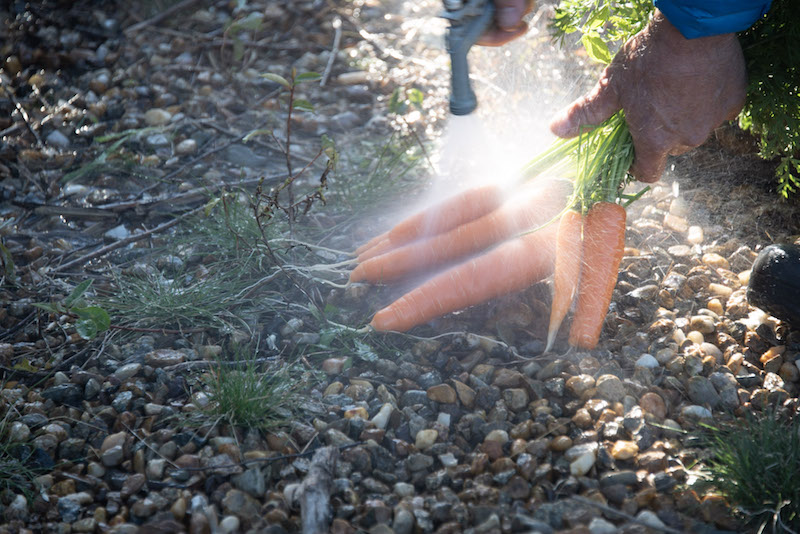Just a few years ago, you might have found Andrew Woodruff behind the wheel of a heavy-treaded tractor, tilling soil and plowing down cover crops on his Whippoorwill Farm in West Tisbury.
But the time-honored tractor is giving way to different equipment on the land Mr. Woodruff tends today, at Island Grown Initiative’s Thimble Farm in Vineyard Haven.
“The tarp is the tool of choice on the farm now,” Mr. Woodruff said this week. “Not the tractor, but the tarp.”
Mr. Woodruff is about three years into a project to rebuild Thimble Farm’s vegetable fields using the techniques of regenerative agriculture, an increasingly popular way of farming based on pre-industrial methods.
Instead of finishing up a cover crop by plowing it into the soil with a tractor, regenerative farmers like Mr. Woodruff use huge tarps to smother the plants in place with their roots still in the ground.
These tools are so important that Island Grown applied for, and received this week, a grant from the Permanent Endowment from Martha’s Vineyard to buy tarps for the farm.
“It eliminates you doing tillage,” Mr. Woodruff said, helping to achieve the first principle of regenerative agriculture: reducing disturbance of the soil, in order to preserve organic matter and prevent carbon from escaping into the atmosphere.
Soil is a complex topic, Mr. Woodruff said. “There’s a lot of new science out there about soil biology, and I’m still very much in the early phases of the learning curve.”
But when it comes to reducing soil disturbance, he said, “it’s all about the carbon.”
Industrial agriculture began emphasizing big tilling machinery and chemical fertilizers in the 1940s, Mr. Woodruff said.
“That led to the destruction of soil structure. Today we have two per cent, if we’re lucky three per cent organic material in the soil, whereas we originally had six to eight per cent,” he said.
Meanwhile, “60 per cent of the carbon worldwide has probably gone into the atmosphere,” lost to erosion or released in the farming process, Mr. Woodruff said.
“We’re at a really pivotal point, I believe, in terms of the health of the planet and where we are in terms of producing food,” he said.
“There’s a lot of emphasis worldwide now on trying to figure out how to get carbon out of the atmosphere and back into the soil so that it can support healthier growing systems for agriculture.”
It was his own search for a healthier way to farm that led Mr. Woodruff to Bryan O’Hara’s Tobacco Road Farm in Connecticut a few years ago.
“It’s a little garden of Eden,” he said of the small farm that uses no-till and low-till methods to produce “the most amazing [farm] food that I’ve ever seen in my life,” Mr. Woodruff said.
“I knew that could happen here on this farm, so I started to do these practices here as a lessee and also on my own farm [Whipporwill Farm in West Tisbury] on a small-scale parcel to get familiar with the systems.”
In 2019, Mr. Woodruff began partnering with Island Grown to transition an initial eight acres to regenerative growing, including two and a half acres in production this year.
“I began reducing tillage three years ago on this land,” Mr. Woodruff said. “I’m seeing the changes in the soil structure in the few years of less tillage and more cover crops.”
The soil is less compacted, taking on a desirable granular consistency, the longtime farmer said as he walked among rows of beets, carrots, brassicas and other cool-season crops destined for Thimble Farm’s winter CSA program.
There are more earthworms. “We’re getting definitely healthier results in crop production,” Mr. Woodruff said. “This broccoli, for instance, is really some of the best broccoli I’ve ever grown.”
He also experimented with planting a small patch of sorghum grass, sunhemp and buckwheat seeds as a cover crop, then covering the seeds with three inches of wood chips.
The seeds sprouted through the chips and became the healthiest crop on the farm, Mr. Woodruff said. He’s planning to use wood chips on a larger area next year.
“I believe that might be one of the fastest ways to get the soil moving toward no-till,” he said, noting that the wood chips inoculate the soil with beneficial mycorrhizae. After the cover crops are cut down or smothered, new seeds will be planted through the decaying material of the old.
“In between all that, you can add more compost, add more wood chips,” Mr. Woodruff said.
Along with reducing soil disturbance, he is following the four other key principles of regenerative agriculture: keeping living roots in the soil year round, covering the soil with a protective layer of mulch or decaying organic matter, bringing in animals to graze as part of the crop rotation and planting a wide variety of crops.
“It’s really important to have diversity in your crops and rotations and the species of plants you grow,” Mr. Woodruff said. “Just like a forest that has multiple species growing in it, you want your farm to be the same.”
A cover crop, for instance, should be grown from a mixture of different seeds, like the sorghum-sunhemp-buckwheat mix.
“It creates more diversity in the biology of the soil and it protects the health of the soil,” he said.
The regenerative fields at Thimble Farm are still a work in progress, he said.
“This transition is a very slow process. It will take probably five more years to get to the point where we’re doing really minimal disturbance of the soil.”
He concluded:
“That’s one of the challenging parts.
“It takes a little bit of courage and some time to figure out to do it.”







Comments (6)
Comments
Comment policy »